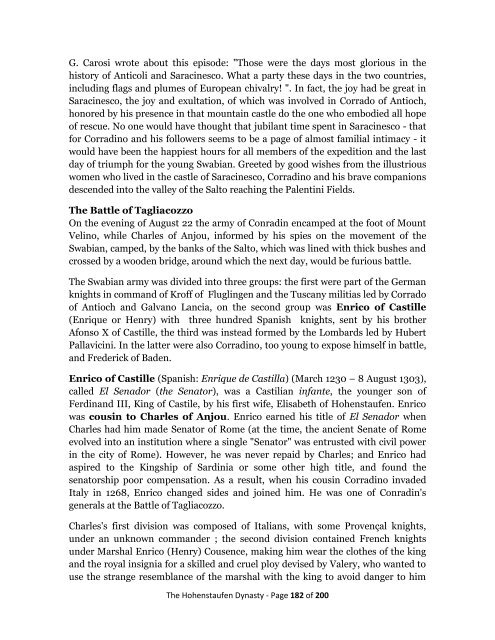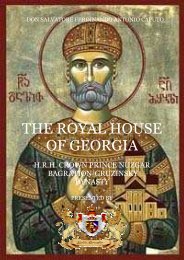here - Nobility Associations
here - Nobility Associations
here - Nobility Associations
Create successful ePaper yourself
Turn your PDF publications into a flip-book with our unique Google optimized e-Paper software.
G. Carosi wrote about this episode: "Those were the days most glorious in the<br />
history of Anticoli and Saracinesco. What a party these days in the two countries,<br />
including flags and plumes of European chivalry! ". In fact, the joy had be great in<br />
Saracinesco, the joy and exultation, of which was involved in Corrado of Antioch,<br />
honored by his presence in that mountain castle do the one who embodied all hope<br />
of rescue. No one would have thought that jubilant time spent in Saracinesco - that<br />
for Corradino and his followers seems to be a page of almost familial intimacy - it<br />
would have been the happiest hours for all members of the expedition and the last<br />
day of triumph for the young Swabian. Greeted by good wishes from the illustrious<br />
women who lived in the castle of Saracinesco, Corradino and his brave companions<br />
descended into the valley of the Salto reaching the Palentini Fields.<br />
The Battle of Tagliacozzo<br />
On the evening of August 22 the army of Conradin encamped at the foot of Mount<br />
Velino, while Charles of Anjou, informed by his spies on the movement of the<br />
Swabian, camped, by the banks of the Salto, which was lined with thick bushes and<br />
crossed by a wooden bridge, around which the next day, would be furious battle.<br />
The Swabian army was divided into three groups: the first were part of the German<br />
knights in command of Kroff of Fluglingen and the Tuscany militias led by Corrado<br />
of Antioch and Galvano Lancia, on the second group was Enrico of Castille<br />
(Enrique or Henry) with three hundred Spanish knights, sent by his brother<br />
Afonso X of Castille, the third was instead formed by the Lombards led by Hubert<br />
Pallavicini. In the latter were also Corradino, too young to expose himself in battle,<br />
and Frederick of Baden.<br />
Enrico of Castille (Spanish: Enrique de Castilla) (March 1230 – 8 August 1303),<br />
called El Senador (the Senator), was a Castilian infante, the younger son of<br />
Ferdinand III, King of Castile, by his first wife, Elisabeth of Hohenstaufen. Enrico<br />
was cousin to Charles of Anjou. Enrico earned his title of El Senador when<br />
Charles had him made Senator of Rome (at the time, the ancient Senate of Rome<br />
evolved into an institution w<strong>here</strong> a single "Senator" was entrusted with civil power<br />
in the city of Rome). However, he was never repaid by Charles; and Enrico had<br />
aspired to the Kingship of Sardinia or some other high title, and found the<br />
senatorship poor compensation. As a result, when his cousin Corradino invaded<br />
Italy in 1268, Enrico changed sides and joined him. He was one of Conradin's<br />
generals at the Battle of Tagliacozzo.<br />
Charles's first division was composed of Italians, with some Provençal knights,<br />
under an unknown commander ; the second division contained French knights<br />
under Marshal Enrico (Henry) Cousence, making him wear the clothes of the king<br />
and the royal insignia for a skilled and cruel ploy devised by Valery, who wanted to<br />
use the strange resemblance of the marshal with the king to avoid danger to him<br />
The Hohenstaufen Dynasty - Page 182 of 200



